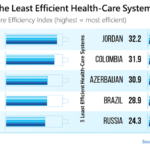The current health care delivery system is complex, often inefficient, and can be challenging to navigate. In order to properly understand the system, it is important to look at the various components, the stakeholders involved, and the ways in which individuals and communities can improve the system. This article will delve into the current health care delivery system, exploring its strengths, weaknesses, and opportunities for improvement. Readers will gain insight into how the system works, who is involved, and what efforts can be made to ensure that all individuals have access to affordable, quality healthcare.
The Role of Technology in Healthcare Delivery

Technology is revolutionizing healthcare delivery like never before! From EHRs to remote monitoring systems, the use of tech is making it easier than ever for providers to deliver quality care to patients. Electronic health records (EHRs) allow physicians to access a patient’s entire medical history quickly and easily, while remote monitoring systems allow clinicians to keep an eye on their patients even when they’re not in the office. Telemedicine is also becoming increasingly popular, giving patients access to quality care without having to leave their homes. Technology is making it easier to treat patients faster and more efficiently, leading to improved health outcomes and better patient satisfaction.
The Impact of Health Care Delivery Systems on Patient Outcomes
The impact of health care delivery systems on patient outcomes is undeniable. As medical technology continues to evolve, so do the way that patients receive care. With the advent of new treatments and technology, it is increasingly important for health care providers to keep up with the latest developments in order to ensure the best outcomes for their patients. Health care delivery systems are designed to provide the most efficient and effective way to deliver care, and when they are used properly, they can significantly improve patient outcomes. For example, telemedicine is becoming increasingly popular, as it allows patients to access care from anywhere in the world. This has helped reduce wait times, costs, and improved access to care. Additionally, electronic medical records have allowed for improved data tracking, which can help providers better tailor treatments to their patients’ individual needs and track their progress. Ultimately, health care delivery systems are essential for providing the best possible care for patients, and when used properly, can have a major impact on patient outcomes.
The Benefits of Collaborative Healthcare Delivery

Collaborative healthcare delivery is a great way to ensure that everyone involved in the patient’s care is on the same page. When healthcare professionals from different disciplines and organizations come together to provide a comprehensive treatment plan for a patient, it can help to ensure the best possible outcomes. By coordinating services and resources, collaborative healthcare delivery ensures that patients receive the most comprehensive and effective treatment possible. This type of healthcare delivery model also encourages the sharing of best practices, allowing healthcare professionals to learn from one another and become better providers. By working together, healthcare professionals can provide better patient care, resulting in fewer medical errors, improved patient satisfaction, and better outcomes.
Strategies for Improving Health Care Delivery Systems

When it comes to improving health care delivery systems, there are a few key strategies that can be used to make sure that everyone is getting the best possible care. One of the most important strategies is to make sure that the system is well-funded and has access to the latest technology. This will help ensure that the system can provide quality care for all patients. Additionally, it is important to ensure that the system is staffed with experienced and qualified professionals who are able to provide the best possible care. Lastly, the system should be set up to provide preventive care, which will help reduce the cost of health care and provide better overall health outcomes for all individuals. By taking these steps, the health care delivery system can be improved and better serve the needs of everyone.
The Role of Health Care Financing in Health Care Delivery Systems

Health care financing plays an integral role in the entire health care delivery system. Financing is basically the money needed to pay for health care services and it can come from a variety of sources. Traditional methods of financing health care include government programs such as Medicare, Medicaid and private health insurance. These methods of financing provide the financial resources needed to meet the costs of medical care. Additionally, there are other sources of financing such as out-of-pocket payments, charitable contributions, and philanthropy. Each of these sources of financing can help to ensure that people have access to the health care services that they need. The way that health care is financed can also have a big impact on the overall quality of the health care services that are provided. By understanding the importance of health care financing, it is possible to ensure that the health care delivery system is working as efficiently and effectively as possible.




